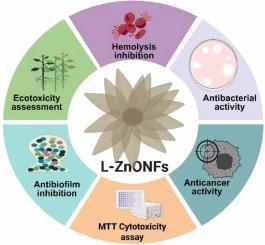Lignin produced nano zinc oxide flower particles and their antimicrobial, antibiofilm, invitro anticancer activity and toxicity on seed germination
IF 6.2
1区 农林科学
Q1 AGRICULTURAL ENGINEERING
引用次数: 0
Abstract
Nanoscience is currently investigating the use of plant extracts to synthesize metal/metal oxide nanoparticles (NPs). This approach is extremely promising, offering many advantages over conventional methods. The current investigation deals with eco-friendly and cost-effective bio nanocomposites were prepared using lignin-fabricated zinc oxide (L-ZnO), which is recognized as a valuable compound in the treatment regime due to its unique physical and chemical properties. UV visible absorption peak for ZnONFs shows the maximum absorption at a wavelength of 375 nm. Microscopy techniques such as field emission scanning electron microscopy (FE-SEM) and high-resolution transmission electron microscopy (HR-TEM) described precise morphological characteristics of nanoflowers. A TEM image shows flower-like structures, petal edges with 202.23 ± 23.41 nm in diameter, and 281.69 ± 49.04 nm in a length. A cell viability test performed on HepG2 cells shows a decrease in cell viability in proportion to the concentration of L-ZnONFs in 3-(4,5-dimethylthiazol-2-yl)-2,5-diphenyltetrazolium bromide (MTT) with an IC50 value of 135 ± 6.75 μg/mL. Fluorescence-Activated Cell Sorting (FACS) analyses using Annexin V confirmed that L-ZnONFs induced apoptosis in HepG2 cells. Antimicrobial results demonstrated that the synthesized L-ZnONFs were more effective against Gram-negative bacteria (E.coli, K.pneumoniae, and S.typi) than Gram-positive bacteria (C. diphtheriae). The L-ZnONFs also demonstrated significant anti-biofilm effects in C. diphtheriae. In addition, L-ZnONFs were assessed for their impact on germination and growth in Raphanus sativus (radish), emphasizing their possibility as sustainable agrochemicals. These verdicts demonstrated that L-ZnONFs modified with lignin possess anticancer, and antibacterial properties, and can be used for therapeutic and agriculture field.

木质素制备的纳米氧化锌花颗粒及其抑菌活性、抗生物膜活性、体外抗癌活性和对种子萌发的毒性
纳米科学目前正在研究利用植物提取物合成金属/金属氧化物纳米粒子(NPs)。这种方法非常有前途,与传统方法相比有许多优点。目前的研究是利用木质素制造的氧化锌(L-ZnO)制备生态友好且经济高效的生物纳米复合材料,由于其独特的物理和化学性质,它被认为是一种有价值的处理方案。ZnONFs的紫外可见吸收峰在375 nm处达到最大吸收。显微镜技术,如场发射扫描电子显微镜(FE-SEM)和高分辨率透射电子显微镜(HR-TEM)描述了纳米花的精确形态特征。TEM图像显示花瓣状结构,花瓣边缘直径为202.23 ± 23.41 nm,长度为281.69 ± 49.04 nm。对HepG2细胞进行细胞活力试验,结果表明,3-(4,5-二甲基噻唑-2-基)-2,5-二苯基溴化四唑(MTT)中L-ZnONFs的浓度与细胞活力成正比降低,IC50值为135 ± 6.75 μg/mL。Annexin V荧光活化细胞分选(FACS)分析证实L-ZnONFs诱导HepG2细胞凋亡。抑菌实验结果表明,合成的L-ZnONFs对革兰氏阴性菌(大肠杆菌、肺炎克雷伯菌和typi沙门氏菌)的抑菌效果优于革兰氏阳性菌(白喉杆菌)。L-ZnONFs对白喉支原体也有明显的抗生物膜作用。此外,还评价了L-ZnONFs对萝卜发芽和生长的影响,强调了其作为可持续农药的可能性。这些结果表明,木质素修饰的L-ZnONFs具有抗癌和抗菌的特性,可用于治疗和农业领域。
本文章由计算机程序翻译,如有差异,请以英文原文为准。
求助全文
约1分钟内获得全文
求助全文
来源期刊

Industrial Crops and Products
农林科学-农业工程
CiteScore
9.50
自引率
8.50%
发文量
1518
审稿时长
43 days
期刊介绍:
Industrial Crops and Products is an International Journal publishing academic and industrial research on industrial (defined as non-food/non-feed) crops and products. Papers concern both crop-oriented and bio-based materials from crops-oriented research, and should be of interest to an international audience, hypothesis driven, and where comparisons are made statistics performed.
 求助内容:
求助内容: 应助结果提醒方式:
应助结果提醒方式:


